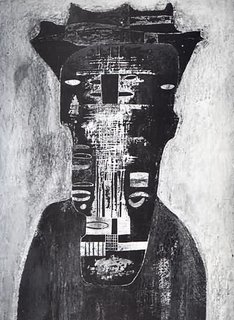
SYLLABUS
Instructor: Alfredo Triff, Ph.D.
Email: (Given in class)
Phone: 305. 237.7554
Text: Miami Arts Explosion: The New Times Column, by Alfredo Triff + my handouts (See Bibliography).
Introduction
Art106 is a foundational course. It explores important issues in art appreciation, criticism and the sociology of art. The idea is to learn relevant aspects of art theory while looking at and writing about art.
A human activity with different purposes, we can see art as a cultural expression, as a social activity, an economic by-product, a political tool, etc. The nature of today’s art-world is so complex that one cannot properly grasp everything exclusively from a single point of view.We’ll look at the art market (i.e. dealers, auctions houses), media (public opinion, critics and historians) academia (educational institutions, curricula) and the public in general, to which this art is presumably directed. As a rule, the more one takes into account one’s cultural and socio-economic predicaments, the less his or her art becomes an exclusive personal activity.
Art106 is supposed to be a fun course: Frequently, we will visit shows in museums and/or galleries. In addition, I've programmed a series of class presentations with important artists, gallerists, critics and curators from Miami.
Materials and Policy
1- (a) Website reports (weekly, due by Wednesday 12 noon): It requires you to write a minimum 120-word comment per post (35%)
(b) Take home quizzes (based on reading from my book or handouts or excerpts (10%)
(c) Reports on -at least three- local exhibitions (10%)
(e) Final paper (25%)
(f) Attendance & participation=10%
2- Grades A, B and C stand for outstanding, good and average respectively. D is below average.
3- One non-excused absence is permitted. Each absence thereafter will need a doctor’s note. If not, it may lower the participation grade. Missing a quiz must be justified by a doctor’s note or the equivalent. Please, feel free to contact me if you have a serious problem with, or in the class.
(Tentative) Schedule of Classes
January 18: General outline of ART 106. Issue #1: What is art? Open discussion.
January 25: Issue #2: Symbols in art (The aesthetic recipient, the aesthetic object and aesthetic experience. The role of the imagination: Emotion, response and enjoyment).
Invited guest: Omar Summereyns
February 1: Issue #3: Art & Politics (Propaganda)
Invited guest: Beatriz Monteavaro
Feburary 8: Issue #4: Commercial Art (Advertisement)
Invited guest: Jordan Massengale
February 15: Issue #5: Conceptual art
Invited Guest:
February 22: Issue #6: Art & Sex (Pornography)
Invited Guest:
March 1: Issue #6: Art & The Body (Feminism, Self-destruction, the sacred body, Robots, etc)
Invited Guest:
March 8: Issue#7: Art & Spirituality (The Shaman)
Invited Guest:
March 15: Issue#8: Blasphemy (Piss Christ & Mohammed’s caricatures)
Invited guest:
March 22: Issue#9: Art & Media (Video, photography, film)
Invited guest:
March 29: Issue #10: Art & Culture 1- Folk-art; 2- Artisan culture; 3- Clerical culture; 4- Ecstatic culture; 5- Genius culture; 6- Professional culture; 10- Applied arts culture; 11- Mass-art; 12- Avant-garde; 13- Totalitarian culture.
April 5: Issue #11: Functions of art
Invited Guest:
April 12: Issue #12: The Art Market
Invited Guest:
April 19: Issue #13: Style in Art
Invited Guest:
April 26: Final Papers Due
________________________
Bibliography for my handouts
Design
Paul Klee, Paths of the Study of Nature. John Dewey, Art as Experience, (Minton Balch & Co.: New York, 1934). Walter Gropius, The New Architecture of the Bauhaus (New York: New York Museum of Modern Art, Faber & Faber, 1936). Wassily Kandinsky, On the Spiritual in Art (New York: Solomon Guggenheim Foundation, 1946) J.C. Feldster, Design Fundamentals (New York: Pitman Publishing Corporation, 1950). Lewis Mumford, Art and Techniques (New York: Columbia University Press, 1952). Rudolph Arheim, Art and Visual Perception: A Psychology of the Creative Eye (Los Angeles: University of California Press, 1954). Johannes Itten, Design and Form: The Basic Course at the Bauhaus, rev. ed. (1975; originally published in German, 1963). A Grammar of Color: A Basic Treatise on the Color System by Albert H. Munsell (1969); The influence of photography on painting is examined in Aaron Scharf, Art and Photography (1968, reissued 1974).
Aesthetics
Two good compilations are, Joseph Margolis (ed.), Philosophy Looks at the Arts, 3rd ed. (1987). John Hospers, Introductory Readings in Aesthetics (1969); and Harold Osborne (ed.), Aesthetics (1972), which contains a particularly useful bibliography. More recent collections include Richard Shusterman (ed.), Analytic Aesthetics (1989); and Philip Alperson (ed.), The Philosophy of the Visual Arts (1992). Monroe C. Beardsley, Aesthetics: Problems in the Philosophy of Criticism, 2nd ed. (1981), provides a broad, scholarly overview of the subject; while Richard Wollheim, Art and Its Objects, 2nd ed. (1980, reissued 1992), is more narrow. A comprehensive survey is also attempted in David E. Cooper (ed.), A Companion to Aesthetics (1992). For the definition of aesthetics, the above texts are relevant, as are Roger Scruton, The Aesthetics of Architecture (1979); Paul Ziff; George Dickie, Aesthetics: An Introduction (1971) and Nicholas Wolterstorff, Works and Worlds of Art (1980).The first approach to the subject as addressed in the article is exemplified in John Casey, The Language of Criticism (1966); the second in Roger Scruton, Art and Imagination (1974, reissued 1982); and the third in Wollheim's book (above). The aesthetic object is dealt with in considerable detail by Roman Ingarden, The Literary Work of Art (1973; originally published in German, 1931); and Mikel Dufrenne, The Phenomenology of Aesthetic Experience (1973; originally published in French, 1953). In addition to the works already cited, the following are particularly important discussions of paradoxes: Ludwig Wittgenstein, Lectures & Conversations on Aesthetics, and Psychology and Religious Belief, ed. by Cyril Barrett (1966).
No comments:
Post a Comment